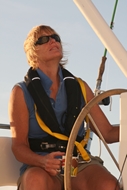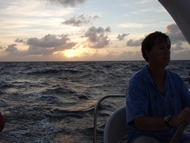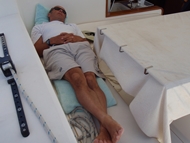Home run to the Tuamotus

|
14:14.768S 139:44.790W Since leaving Balboa on the
We seem to have settled into our new
life, with constantly strong winds - 18 to 30 knots from the East – and boat
speeds of up to 13 knots. For
safety reasons, we are now goose-winging only during daylight hours and heading
up slightly to a broad reach during the night. Our average boat speed for the past two
24 hour periods was 8.4 knots for each, and our 24 hour run was 202 and 203
miles respectively.
The weather has been patchy with 50% cloud cover for
the past two days, and occasional bursts of rain under big clouds. After weeks of seeing nothing, we have
seen three ships in the past two days – two ‘rust-bucket’ freighters heading
north, and a super-tanker heading towards For the fourth day running we have had large rolling seas coming at us from the port quarter and disappearing under us, making Rumpelteazer follow a somewhat erratic course as she gets buffeted from astern and lurches at an angle and great speed down a big wave. Cooking is a major test of balance and of juggling as we, pans and ingredients slide from one side of the saloon to the other, and we are not currently getting a lot of sleep. It’s all quite exhiliarating during daylight, and hand-steering is a great test of our sailing skills, but as night falls, some of us of less brave disposition (ie Pippa) get filled with trepidation.
Not being able to see the horizon, or
the seas around us – the half-moon appeared briefly last night to give us more
light – can be seriously disorienting when travelling at such speeds, so we are
hugely dependent on ‘George’ for keeping us safe during the night. Whoever is on watch spends a lot of time
at the wheel, giving him moral support and helping him out of his most serious
lurches by pressing his 1° to port or 1° to starboard buttons as required. We are constantly watching the wind
direction, wind strength and the Radar screen warning us of those ominous black
clouds coming up behind us requiring us to reef. But there are also the better moments on night watches, spotting the shooting stars, watching Max’s Southern Cross move across the sky, seeing the sun rise and enjoying the phosphorescence, some of it as big as dinner plates, as we rush through it and leave it behind us, flashing in our twin wakes. We are also still collecting lots of tiny flying fish which collide with us during the night and get stuck to the windows and hulls. Their larger relatives get thrown back into the sea in the morning.
On Friday night Andy was on the midnight to 3am watch and spotted a menacing black cloud pursuing us. Single-handedly he shortened the genoa and put the 2nd reef into the main as the wind indicator rose rapidly to 36knots. Captain Robert, alerted by the noises on deck, rushed up too late to assist, but was able to bestow on Andy the ship’s award for heroism. During his watch Andy also recorded a GPS boat speed of 25.1knots – we are not sure whether this was real or a blip on the GPS but we were travelling very fast.
Kepa II, the cataraman a day or so
behind us, has found the going very tough (with only two crew) and texted us to
say they were detouring further north to Nuku Hiva in the Marquesas for an
unscheduled stop to recover and re-provision. Had we stuck with our original plan we
would be arriving in the Marquesas today, 20 days after leaving the
Galapagos. Instead, we are three days from the
Tuamotus. |


